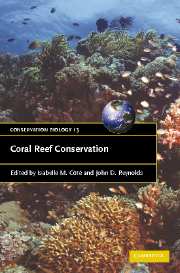Book contents
- Frontmatter
- Contents
- List of contributors
- Foreword
- Preface
- Part I Setting the stage
- Part II Uses and abuses: ecological and socio-economic issues
- 5 Challenges and accomplishments towards sustainable reef fisheries
- 6 Live food and non-food fisheries on coral reefs, and their potential management
- 7 Tourism and coral-reef-based conservation: can they coexist?
- 8 Longer-term impacts of climate change on coral reefs
- Part III The way forward: tools and approache
- Index
- Plate section
- References
7 - Tourism and coral-reef-based conservation: can they coexist?
Published online by Cambridge University Press: 05 June 2012
- Frontmatter
- Contents
- List of contributors
- Foreword
- Preface
- Part I Setting the stage
- Part II Uses and abuses: ecological and socio-economic issues
- 5 Challenges and accomplishments towards sustainable reef fisheries
- 6 Live food and non-food fisheries on coral reefs, and their potential management
- 7 Tourism and coral-reef-based conservation: can they coexist?
- 8 Longer-term impacts of climate change on coral reefs
- Part III The way forward: tools and approache
- Index
- Plate section
- References
Summary
INTRODUCTION
Tourism is the world's largest industry, with 694 million international tourist arrivals generating revenues of US$514 billion in 2003 (World Tourism Organization, 2004). Estimates of global coastal tourism range between 40% and 70% of the total tourism market, and beach leisure tourism constitutes a major part of the industry. Due to increased disposable incomes, increased leisure time, and falling prices, the industry is still growing rapidly and is expected to reach 1.6 billion arrivals by 2020 (World Tourism Organization, 2001).
Coral reefs contribute to tourism to a tune of US$9.6 billion yr-1 globally (Cesar, 2003). National values have been calculated as US$23.2 million yr-1 for Bonaire, US$2 million yr-1 in Saba, US$23.5 million yr-1 in West Lombok and US$682 million yr-1 for the Great Barrier Reef (Dixon et al., 1993; Fernandes, 1995; Riopelle, 1995, cited in Cesar, 1996; Driml, 1994). Cesar (2003b) gave a value of US$112 million for Egypt in 2000, including US$23 million in consumer surplus. Reefs not only support niche sub-markets in scuba diving and snorkelling excursions, they also add value to the tourism product through associated images of exoticism and natural beauty.
It is no surprise that in many developing nations with reef resources, tourism is an attractive industry to develop. With long-haul travel becoming cheaper and more available, previously remote areas are becoming part of the tourism mainstream. As part of this development, coastal destinations that previously catered to niche markets in independent and adventure travel are becoming oriented to all-inclusive beach resort holidays.
- Type
- Chapter
- Information
- Coral Reef Conservation , pp. 237 - 263Publisher: Cambridge University PressPrint publication year: 2006
References
- 5
- Cited by



